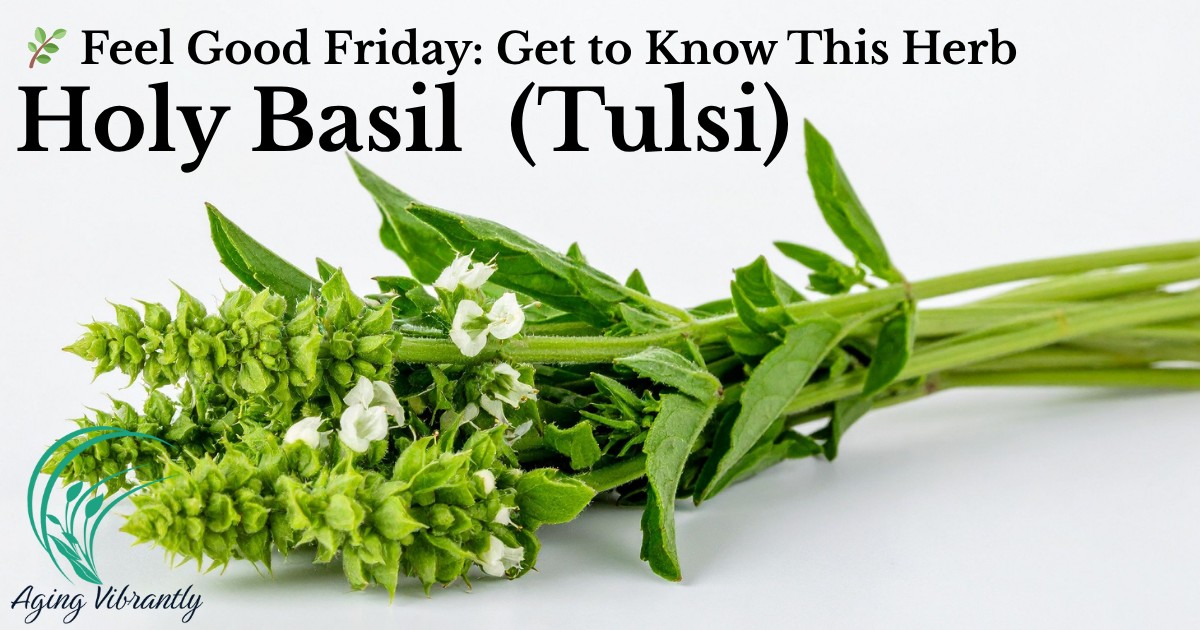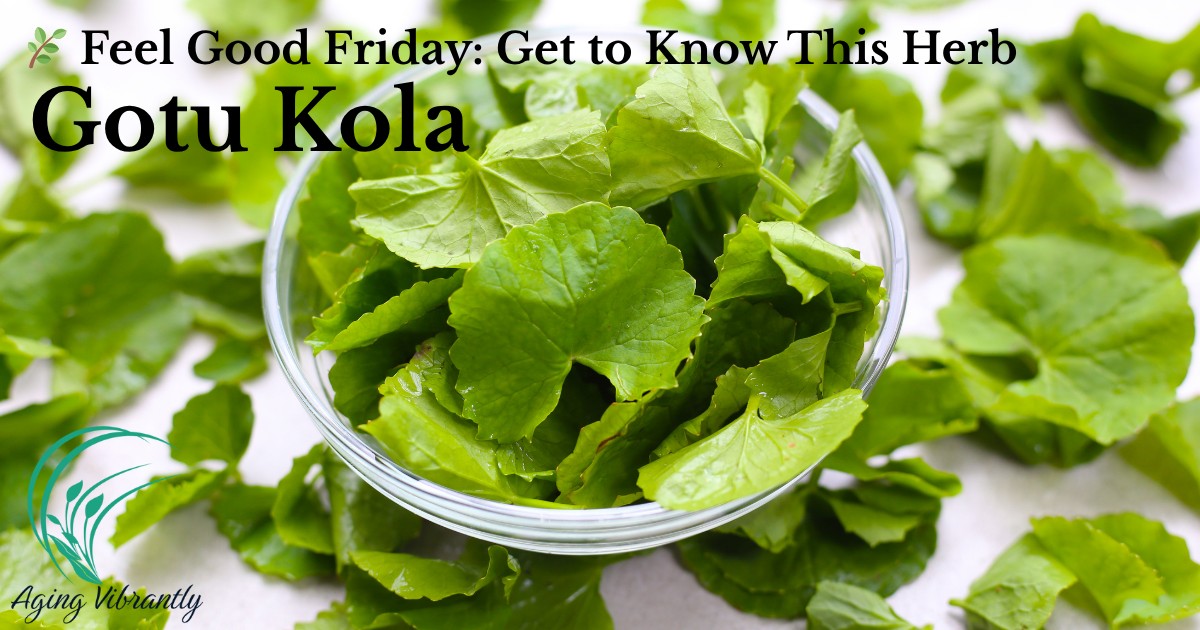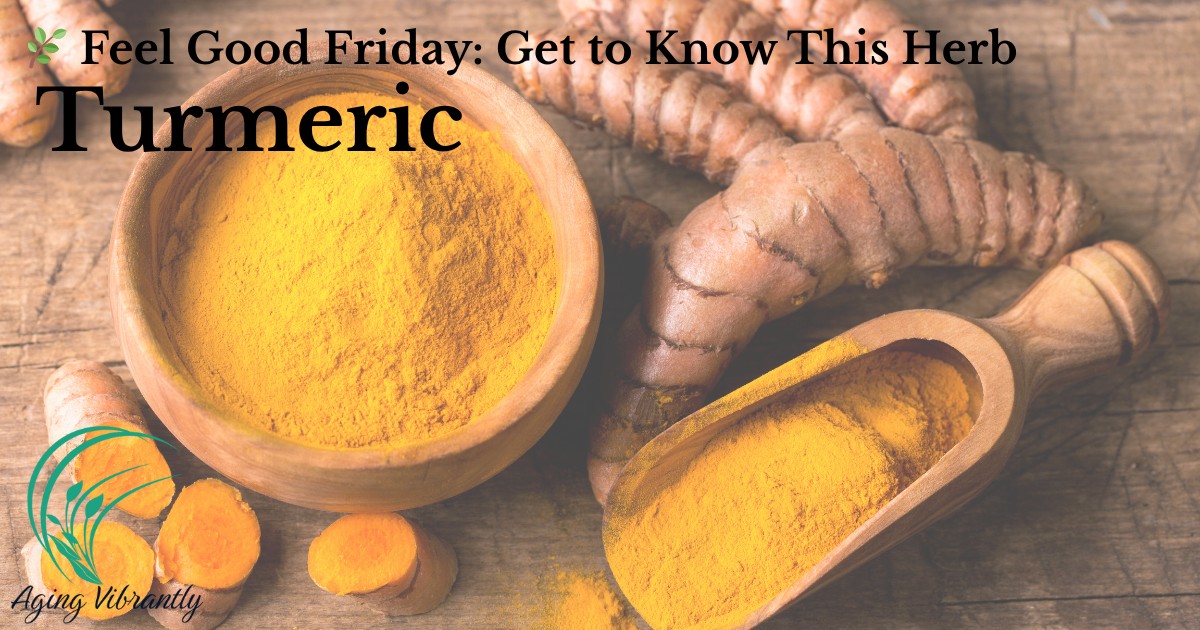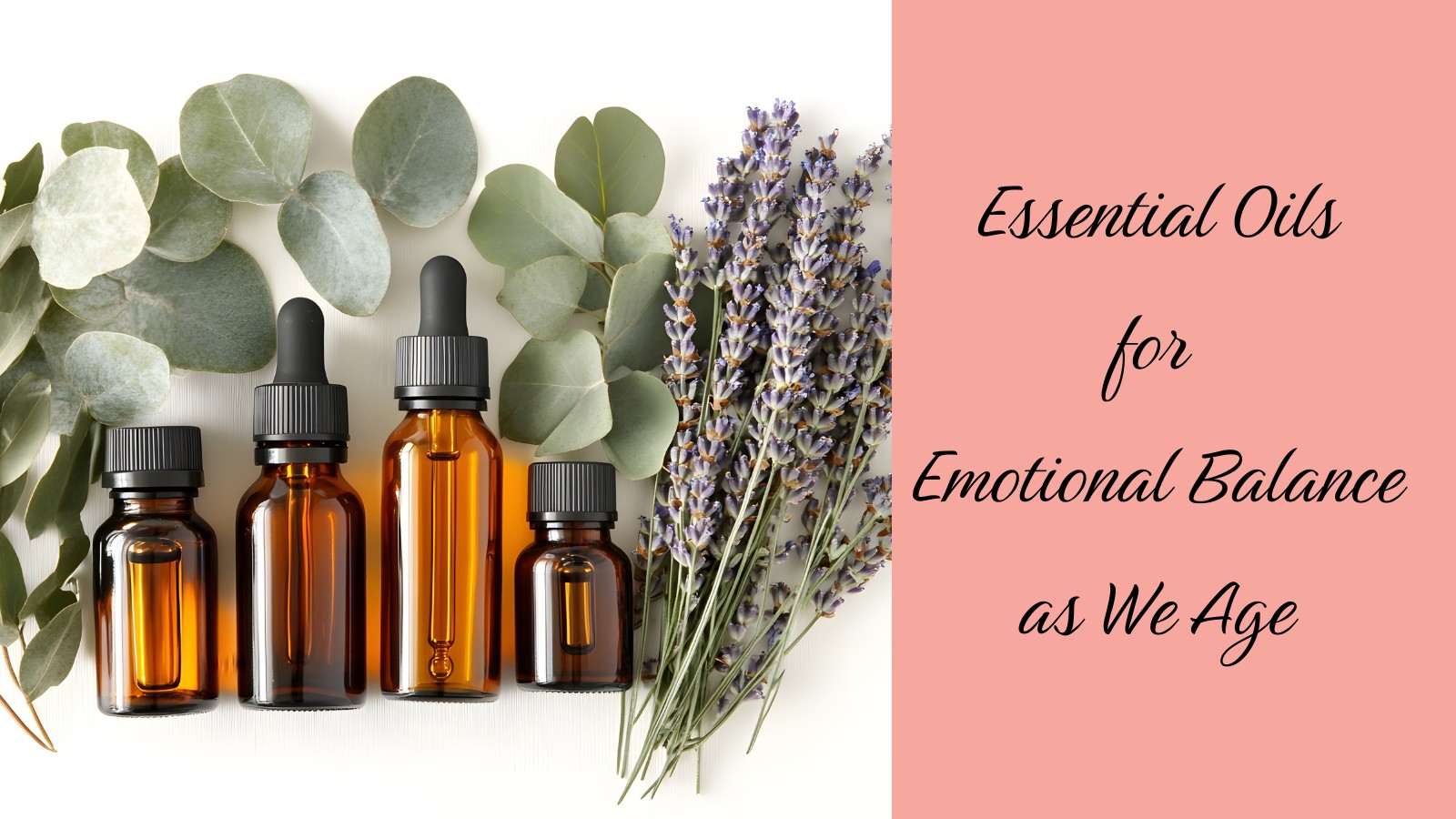
Dive into the transformative power of nature walks as a pathway to vibrant aging, where the simple act of stepping outside offers profound healing for body, mind, and spirit. Discover how strolling on natural terrain can improve balance, boost cardiovascular health, and enhance immunity, making it a gentle yet powerful exercise that nurtures without exhausting. In a world that often demands more than it gives, nature invites a slower, more mindful rhythm that reduces stress, elevates mood, and enhances mental clarity. Embrace walking as a spiritual journey, where each step can be a meditation, connecting us deeper with creation and offering opportunities for gratitude, reflection, and companionship. Whether it's a forest, park, or garden, spending just two hours in nature weekly can significantly increase vitality and life satisfaction. Uncover the simple, sacred rhythm of walking that not only promotes physical well-being but nourishes the soul, helping you age with grace and fullness.
Read more...
Discover the transformative power of gratitude as you age gracefully, and unlock a vibrant way of living that uplifts your mind, body, and spirit. This enlightening blog post delves into how a simple gratitude practice can reshape your brain, boost your heart health, and enhance emotional well-being, helping you handle stress and promote joy. By embracing gratitude, not only do you enrich your personal health, but you also strengthen your relationships, finding abundance and meaning even in life's challenges. Learn how gratitude acts as a spiritual practice, nourishing your soul and opening your heart to love and connection. With actionable daily practices tailored for older adults, this post offers a roadmap to cultivate a lasting attitude of gratitude, showing how life’s later years can be celebrated with wisdom, love, and joy. Explore the science and spirit behind gratitude and elevate your journey through aging with grace and abundant thankfulness.
Read more...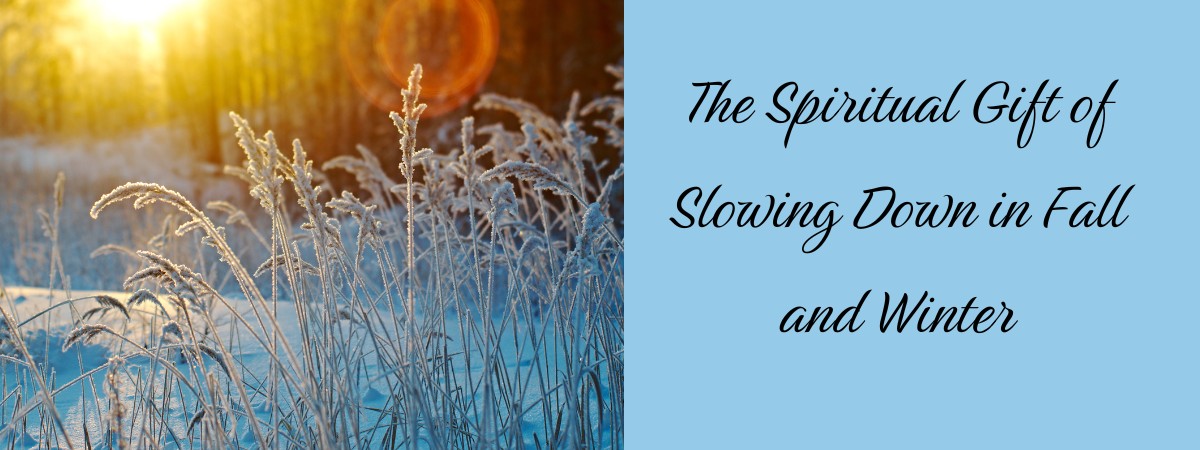
As the air turns crisp, the days grow shorter, and leaves scatter in brilliant shades of red and gold, we’re reminded that fall is a season unlike any other. It is both vibrant and fading, abundant and letting go, lively and slowing down. Fall is nature’s gentle invitation to release the pace of summer and prepare for the deeper stillness of winter.
In our fast-paced world, it’s easy to miss this sacred rhythm. But when we look to creation—and to Scripture—we see that God designed the seasons not just for the earth, but for our souls. Fall and winter together teach us the spiritual gift of slowing down, trusting God’s timing, and resting in His presence.
📖 “There is a time for everything, and a season for every activity under the heavens.” — Ecclesiastes 3:1
Fall: The Season of Transition
Fall is a season of release. Leaves flutter to the ground, harvest fields are cleared, and creation sheds what it no longer needs. In the same way, God calls us to let go of burdens, anxieties, and distractions that weigh us down.
When we pause long enough to notice, fall becomes a spiritual teacher. Just as the trees release their leaves, we are reminded that letting go is not loss—it is preparation for what is to come.
📖 “Cast all your anxiety on Him because He cares for you.” — 1 Peter 5:7
What if, this fall, you asked God: “What are You inviting me to release?” It could be a habit, a fear, or even an unhealthy busyness. As you let go, you create space for God’s renewing work in your life.
🖊 Reflection Prompt: What might God be asking me to release this fall?
The Harvest of Gratitude
Fall is also a season of abundance. We celebrate the harvest, gather around tables, and remember God’s provision. Just as the Israelites brought offerings of their first fruits, we too are called to recognize that everything we have comes from the Lord.
Gratitude slows us down. It draws our attention away from striving and onto God’s goodness. A thankful heart doesn’t rush—it lingers, noticing small blessings like the warmth of a blanket, the crunch of leaves underfoot, or the laughter of loved ones around a meal.
📖 “Give thanks in all circumstances; for this is God’s will for you in Christ Jesus.” — 1 Thessalonians 5:18
Consider making gratitude part of your fall rhythm: jotting down three blessings each day, praying thanks before bed, or sharing one thing you’re grateful for at family meals. Gratitude shifts our hearts from scarcity to abundance, from hurry to peace.
Preparing for Winter’s Rest
Fall doesn’t just stand on its own—it prepares us for what’s ahead. Farmers clear fields so the land can rest. Animals store food before hibernation. Even our daily rhythms begin to change—shorter days encourage earlier nights and cozier gatherings.
Spiritually, fall invites us to prepare our hearts for the deeper rest of winter. This preparation might look like decluttering your schedule, creating margin for prayer, or setting intentions for the coming months.
📖 “Teach us to number our days, that we may gain a heart of wisdom.” — Psalm 90:12
🖊 Reflection Prompt: What can I put in place now—habits, boundaries, or rhythms—that will help me embrace God’s gift of rest in the winter ahead?
Winter: The Deep Pause
When fall fades into winter, the slowing deepens. Trees stand bare, the fields are quiet, and much of creation enters rest. To our hurried hearts, winter may feel stark, even uncomfortable. Yet this is not wasted time. Winter is God’s reminder that rest is necessary for renewal.
📖 “Be still, and know that I am God.” — Psalm 46:10
Stillness may be challenging, but it is also where we hear God’s whisper most clearly. Winter invites us to shift from doing to being, from striving to abiding in Christ.
📖 “Those who wait on the Lord shall renew their strength; they shall mount up with wings like eagles.” — Isaiah 40:31
Just as the earth lies dormant in preparation for spring’s bloom, we too can use winter to rest, recharge, and prepare for what God will bring forth in a new season.
Practices for Slowing Down in Fall and Winter
Here are some ways to honor the spiritual rhythm of these seasons:
In Fall:
- Practice Gratitude: Start a gratitude journal or share blessings at the dinner table.
- Declutter Spiritually and Physically: Release what no longer serves—both in your home and in your heart.
- Celebrate God’s Provision: Host a simple meal with friends or family, focusing on connection over perfection.
In Winter:
- Create Sacred Stillness: Light a candle and spend a few minutes each day in silence with God.
- Deepen in Prayer and Scripture: Choose one Psalm or Gospel passage to meditate on slowly throughout the season.
- Embrace Rest: Prioritize sleep, unhurried walks, or restorative practices like stretching or gentle yoga.
- Connect in Community: Join a Bible study or prayer group that encourages your soul.
📖 “But Jesus often withdrew to lonely places and prayed.” — Luke 5:16
Lessons from Nature
Creation reflects God’s wisdom in every season. Fall teaches us to release and give thanks. Winter shows us the blessing of rest and renewal. Neither is wasted; both are part of the greater rhythm of life.
📖 “The heavens declare the glory of God; the skies proclaim the work of His hands.” — Psalm 19:1
As fall and winter flow together, we see that slowing down is not an interruption—it’s a gift. It’s God’s way of nurturing us so we can grow stronger when spring returns.
🖊 Reflection Prompt: What can I learn from nature’s rhythms that might guide how I live this season more faithfully?
Conclusion: Receiving the Gift of the Seasons
Fall and winter are not seasons to rush through. They are sacred invitations. Fall calls us to release and give thanks. Winter invites us to rest and be still. Together, they remind us that slowing down is not weakness—it is worship.
📖 “In repentance and rest is your salvation, in quietness and trust is your strength.” — Isaiah 30:15
So this year, instead of resisting the shorter days or lamenting the bare branches, embrace the gift of God’s rhythm. Slow down. Give thanks. Rest in His presence.
🖊 Final Reflection Question: How can I live more intentionally in this season, receiving fall and winter as God’s gift rather than something to endure?
🙏 Closing Prayer:
“Lord, thank You for the beauty of fall and the stillness of winter. Teach me to release what I cannot carry, to give thanks for Your provision, and to rest in Your presence. May these seasons draw me closer to You and prepare me for the new life You are bringing. Amen.”
“Lord, thank You for the beauty of fall and the stillness of winter. Teach me to release what I cannot carry, to give thanks for Your provision, and to rest in Your presence. May these seasons draw me closer to You and prepare me for the new life You are bringing. Amen.”

When the air turns crisp and the leaves begin to fall, many people notice something else shifting—stiff, achy joints. If cooler weather leaves you feeling less mobile or more uncomfortable, you’re not alone. For those over 50, seasonal changes can intensify joint pain and stiffness, especially if conditions like arthritis are already in play. The good news? With a few mindful adjustments, you can keep your joints moving smoothly all season long.
❄️1. Stay Warm and Layer Up
Cold temperatures don’t just make you feel chilly—they actually impact your joints on a physical level. When your body gets cold, blood vessels constrict, which reduces circulation to the extremities. This lack of warm blood flow can make joints and muscles feel tighter, less flexible, and more painful, especially if you already deal with arthritis or chronic stiffness. That’s why staying warm isn’t just about comfort; it’s about protecting your joints from unnecessary stress caused by the cold.
Dressing in layers gives you flexibility to stay warm both indoors and outdoors. By layering, you can adapt easily as you move between environments—like a chilly outdoor walk and a warm, heated store. This helps keep your joints from cooling down too quickly, which can trigger stiffness or discomfort. Even small fluctuations in temperature can irritate joints, so layering acts as a buffer, keeping your body consistently comfortable.
Stay Warm and Layer Up — How to do it!
Adding extra warmth directly to sensitive joints can make a big difference.
Consider using wrist or knee warmers, thermal socks, or even special joint sleeves designed for arthritis. Choose a simple layering system: a moisture-wicking base layer (synthetic or merino), an insulating mid-layer (fleece or wool), and a windproof outer layer when you go outside. Keep a small warm pack or heating pad handy for targeted relief—apply for 15–20 minutes to stiff joints before activity (test temperature first and don’t sleep with an active heating pad). At home, create warm micro-habits: a warm footbath before bedtime, a small blanket near your favorite chair, and slippers beside the bed to prevent cold toes first thing in the morning. If circulation issues or diabetes are a concern, advise readers to check with their clinician about safe heat use and compression garments.
🚶♀️2. Keep Moving (Even When You’d Rather Stay Inside)
Movement is one of the most effective natural therapies for joint health. When you move, your body produces synovial fluid—a natural lubricant that helps your joints glide smoothly. In cooler weather, people tend to move less, which means joints don’t get the same level of lubrication and may feel stiffer. Regular activity also strengthens the muscles around your joints, providing them with better support and reducing overall strain. Simply put, motion is medicine for your joints, and it becomes even more essential when temperatures drop.
Low-impact exercises are your best friend during this season. Unlike high-impact activities that can place stress on joints, low-impact movement gently stimulates circulation and encourages flexibility without causing damage. Activities like swimming, tai chi, or yoga also engage balance and coordination, which helps prevent falls—an important consideration as joints age. Choosing these kinds of exercises gives you the benefits of movement while minimizing risks.
Keep Moving — How to do it
The key is consistency rather than intensity. Even short bouts of movement—10 minutes at a time—can make a big difference.
Build movement into your day with short, scheduled sessions: set a phone alarm for three 10–15 minute movement breaks (morning, midday, late afternoon) and use that time for a brisk walk, a gentle chair exercise set, or a few balance drills. Pick 2–3 low-impact activities you enjoy (walking, water aerobics, tai chi) and commit to them weekly—put classes or walks on the calendar so they become non-negotiable. Add simple strength work twice a week (bodyweight, light dumbbells, or resistance bands) to support the muscles around joints—start with 1–2 sets of 8–12 reps and progress slowly. If new to exercise or coping with significant pain, recommend a one-time consult with a physical therapist for a safe, personalized plan.
Build movement into your day with short, scheduled sessions: set a phone alarm for three 10–15 minute movement breaks (morning, midday, late afternoon) and use that time for a brisk walk, a gentle chair exercise set, or a few balance drills. Pick 2–3 low-impact activities you enjoy (walking, water aerobics, tai chi) and commit to them weekly—put classes or walks on the calendar so they become non-negotiable. Add simple strength work twice a week (bodyweight, light dumbbells, or resistance bands) to support the muscles around joints—start with 1–2 sets of 8–12 reps and progress slowly. If new to exercise or coping with significant pain, recommend a one-time consult with a physical therapist for a safe, personalized plan.
🤸3. Stretch Daily
Stretching is crucial because joints and muscles tend to shorten and tighten when they’re not used regularly—a problem made worse by cold weather. Without regular stretching, the tissues surrounding your joints lose flexibility, which can lead to stiffness, limited mobility, and even increased risk of injury. Stretching helps maintain joint range of motion and keeps blood flowing, which is essential for nourishing joint tissues and preventing discomfort. Making stretching a daily practice is like giving your joints a gentle tune-up, ensuring they stay mobile and resilient.
Stretching is often overlooked, but it’s a powerful way to care for your joints. Unlike intense workouts, stretching requires very little time and no special equipment, making it easy to incorporate into your daily routine. Over time, consistent stretching helps retrain your body to stay more open and limber, which reduces the likelihood of sudden aches or limitations. This proactive care gives your joints a better foundation for everything else you do.
Stretch Daily — How to do it
Morning stretches are particularly effective because they help “wake up” your muscles and joints, setting a positive tone for the rest of your day.
Create a short, repeatable stretching routine you can do every morning and evening: 3–5 gentle stretches targeting neck/shoulders, hips, knees and wrists, holding each for 20–30 seconds and breathing slowly. Use seated or supported versions of stretches if balance or pain is an issue—chair hamstring stretches, seated shoulder rolls, and calf raises are great options. Make stretches easier to keep up by pairing them with daily anchors (after brushing teeth, before your morning tea, or at TV commercial breaks). If a stretch increases sharp pain, back off the intensity and try a milder modification; over weeks you can gradually increase range of motion.
💧4. Stay Hydrated
Hydration is more than just quenching thirst—it’s a direct factor in joint health. The cartilage that cushions your joints is made up largely of water, and it depends on hydration to stay soft, spongy, and effective at absorbing shock. When you’re dehydrated, your cartilage loses some of its ability to protect the bones, making joints feel stiffer and more prone to irritation. Cooler weather often suppresses thirst, so you may not realize how little water you’re drinking. By making hydration a conscious habit, you’re actively protecting your joints from unnecessary wear and tear.
Aim for at least 6–8 glasses of water daily, but remember that all fluids count toward hydration. Warm drinks like herbal teas or lemon water not only keep you hydrated but also soothe your body in cooler weather, helping you feel more comfortable overall. Hydration also improves circulation, which ensures that oxygen and nutrients reach your joint tissues effectively. This means water doesn’t just help with cushioning—it also supports healing and nourishment from within.
Stay Hydrated — How to do it
Fruits and vegetables with high water content, like oranges, cucumbers, and berries, also contribute to hydration.
Make hydration automatic with practical tools: keep a refillable water bottle (20–24 oz) at your side, set hourly sips reminders on your phone, and start the day with a warm mug of lemon water or herbal tea. Count soups, broths, and high-water foods (citrus, cucumber, melon) toward your total—if plain water feels boring, add a slice of citrus or a drop of citrus Vitality oil for flavor. Track intake for a few days (notes or an app) to see if you’re hitting your target; adjust for activity level, medications, or health conditions and check with your clinician if you’re on fluid-restricted diets. In cooler weather, warm drinks are comforting and effective, so trade one cold glass for a hot infusion if that helps you drink more.
Make hydration automatic with practical tools: keep a refillable water bottle (20–24 oz) at your side, set hourly sips reminders on your phone, and start the day with a warm mug of lemon water or herbal tea. Count soups, broths, and high-water foods (citrus, cucumber, melon) toward your total—if plain water feels boring, add a slice of citrus or a drop of citrus Vitality oil for flavor. Track intake for a few days (notes or an app) to see if you’re hitting your target; adjust for activity level, medications, or health conditions and check with your clinician if you’re on fluid-restricted diets. In cooler weather, warm drinks are comforting and effective, so trade one cold glass for a hot infusion if that helps you drink more.
🥗5. Nourish Your Joints from Within
The foods you eat have a profound effect on inflammation, which is one of the main culprits behind joint pain. Processed foods, sugar, and unhealthy fats can trigger inflammation, making discomfort worse, while nutrient-rich foods calm the body’s inflammatory response. Anti-inflammatory nutrients like omega-3 fatty acids, vitamin D, and antioxidants not only reduce swelling but also help protect cartilage and connective tissues. Choosing the right foods is essentially choosing whether to fuel your joints with healing or with harm. That’s why nutrition is one of the most powerful tools you can use to keep your joints happy, especially during cooler seasons when aches often flare.
Vitamin D also plays a crucial role, particularly in cooler months when sunlight exposure is limited. When vitamin D levels drop, bones and joints become more vulnerable, and immune responses may trigger more inflammation. Ensuring you get enough through foods or supplements helps safeguard your skeletal and joint health during the darker months. This makes nutrition a protective strategy, not just a source of energy.
Nourish Your Joints from Within — How to do it
Antioxidants from colorful fruits and vegetables further support joint health by protecting tissues from oxidative stress.
Make anti-inflammatory eating simple by planning: include a serving of fatty fish (salmon, sardines) or a plant omega source (flaxseed, chia, walnuts) two to three times a week, and add a colorful vegetable to every meal. Use turmeric and fresh ginger in soups, stews, and smoothies—pair turmeric with black pepper and a healthy fat (olive oil, avocado) to improve absorption. Reduce inflammatory triggers by minimizing processed snacks and sugary drinks; swap a sugary treat for a handful of berries and yogurt or a spiced nut mix. If supplements are being considered (turmeric/curcumin, glucosamine, omega-3), encourage readers to discuss dosage and interactions with their healthcare provider before starting.
🥾6. Protect Your Joints Outdoors
Venturing outside in cool or icy weather puts extra stress on joints, particularly weight-bearing ones like hips, knees, and ankles. The cold makes muscles less pliable, while slick surfaces increase the risk of falls and sudden impacts on joints. Even small slips can jolt your joints, causing inflammation or injury. By taking precautions with footwear, gear, and warm-up routines, you minimize those risks and create safer conditions for your joints. Outdoor activities can be wonderful for mental health, but they’re only beneficial if your joints are protected in the process.
Walking poles or canes with rubber tips can also reduce the pressure on hips and knees while providing extra stability on uneven paths. This support helps distribute weight more evenly, relieving the joints of excess strain during walks or hikes. Even if you don’t need extra support every day, having these tools available for colder months can make outdoor activities more accessible and enjoyable.
Protect Your Joints Outdoors — How to do it
Don’t forget to warm up before heading outside. A few minutes of gentle stretching or marching in place can loosen stiff muscles and joints.
Prepare for outdoor outings: choose shoes with good tread and ankle support, add removable traction devices on icy days, and bring walking poles if you’ll be on uneven ground to offload knees and hips. Warm up for 5–10 minutes (marching in place, dynamic leg swings, gentle knee bends) before stepping out so muscles and joints are primed for movement. Plan routes with safer surfaces (cleared sidewalks, paved paths), avoid going out during the coldest parts of the day if possible, and carry a small emergency kit (phone, warm gloves, a compact heat pack). When conditions are risky, swap an outdoor walk for a safe indoor alternative—mall walking, a community center class, or a guided video at home.
.
🧘7. Listen to Your Body
Pain is the body’s way of sending a message, and when it comes to joint health, ignoring those messages can backfire. Overexertion, pushing through sharp pain, or ignoring recurring soreness often leads to inflammation, swelling, or even long-term joint damage. On the other hand, tuning in and responding with gentleness—whether that means resting, applying heat, or choosing a low-impact exercise—allows your joints time to recover. Listening to your body isn’t about avoiding activity; it’s about respecting your body’s limits so that you can stay active for the long haul.
Instead, honor your limits and choose activities that feel supportive rather than punishing. Respecting what your body needs fosters long-term health and reduces the risk of injury. It also teaches you to view movement as a tool for well-being, not as a battle to be won. This mindset shift helps you cultivate consistency in self-care rather than cycles of overdoing and recovery.
Listen to Your Body — How to do it
If high-impact exercise causes pain, switch to gentler movements like walking or chair yoga.
Use simple self-monitoring tools: keep a short joint diary noting pain level (1–10), swelling, activity that preceded discomfort, and helpful remedies (heat, rest, meds). Learn basic symptom rules—rest and ice for new swelling or acute injury (first 48–72 hours), heat for general stiffness before movement—and alternate as needed; if pain is prolonged, worsening, or accompanied by redness/fever, seek medical attention. Build recovery into your schedule: plan at least one full rest day after a more active session, and be ready to substitute gentler options when your body signals fatigue—this steady responsiveness prevents flare cycles and supports long-term mobility.
Bottom Line: Cooler weather doesn’t have to mean painful, stiff joints. By staying warm, active, nourished, hydrated, and mindful of your body’s needs, you can move through the season with greater comfort and vitality.
👉 Would you like more holistic wellness tips for vibrant living after 55? Subscribe to Aging Vibrantly Weekly and get encouragement, resources, and practical tools straight to your inbox.
👉 Receive Your FREE Premiere Issue of Aging Vibrantly Quarterly by signing up HERE by December 1st!
Please share your successes and challenges keeping your joints happier in cooler weather! Let's help each other stay active and feeling great!

Why Key Nutrients Matter More After 55
As we age, our immune system naturally changes—a process called immunosenescence. This means our bodies don’t always respond to infections as quickly or as strongly as they once did. The good news? The right nutrition can make a significant difference in keeping your defenses strong and helping you stay active, healthy, and resilient well into your later years.
Nutrients That Matter Most After 55

- Vitamin A – Supports healthy skin, eyes, and respiratory lining, your body’s first barrier against germs.
- Why it matters now: Older adults may absorb vitamin A less efficiently, so foods like pumpkin, sweet potatoes, and leafy greens are extra important.
- Vitamin C – Enhances white blood cell activity and reduces healing time.
- Why it matters now: Wound healing and recovery from illness can take longer after 55, making vitamin C-rich foods like citrus, apples, and kale vital.
- Vitamin D – Activates immune defenses and strengthens bones.
- Why it matters now: With age, the skin makes less vitamin D from sunlight, and deficiency is common in adults over 55. Consider safe sun exposure, fortified foods, or supplements.
- Vitamin E – Protects immune cells from damage.
- Why it matters now: Aging increases oxidative stress; vitamin E from nuts, seeds, and avocados helps defend your cells.
- Zinc – Essential for immune cell production and wound healing.
- Why it matters now: Zinc absorption declines with age, and deficiency is linked to higher risk of infections. Enjoy pumpkin seeds, beans, and whole grains.
- Iron – Supports oxygen delivery and energy.
- Why it matters now: Fatigue and weakness may be linked to low iron, especially in older women. Iron-rich foods like spinach, beans, and lean meats are important.
- Selenium – Regulates immune response and reduces inflammation.
- Why it matters now: Selenium has been shown to help protect against age-related decline in immunity. A single Brazil nut daily can provide what you need.
- Omega-3 Fatty Acids – Reduce chronic inflammation and protect heart health.
- Why it matters now: Older adults often face joint stiffness, heart concerns, and inflammation. Omega-3s in salmon, flaxseeds, and walnuts support both immune and cardiovascular health.
- Probiotics & Prebiotics – Strengthen gut health, where much of the immune system lives.
- Why it matters now: The balance of gut bacteria shifts with age, impacting immunity and digestion. Yogurt, kefir, garlic, onions, and fermented foods restore healthy gut function.
Bottom Line for Aging Vibrantly
After 55, the immune system needs more intentional care. Nutrients become not just helpful—but essential—to reduce the risk of infections, support healing, and maintain energy. By focusing on a colorful, balanced diet rich in these nutrients, you give your body the foundation it needs to thrive in this vibrant stage of life.
Eating well is not just about adding years to your life—it’s about adding life to your years.
Which Fall Favorites Are Best?
As the crisp air rolls in and the days grow shorter, our bodies naturally crave warmth, nourishment, and comfort. Fall is not only a season of colorful leaves and cozy sweaters—it’s also a perfect time to strengthen your immune system. With cold and flu season approaching, the foods you put on your plate can make a big difference in how resilient you feel. Let’s look at some of the best fall foods that help fuel your immune health.

1. Pumpkin and Winter Squash
Pumpkins and their cousins (butternut, acorn, delicata) are more than just autumn decorations. They’re rich in vitamin A and beta-carotene, which support the immune system by protecting the lining of the respiratory and digestive tracts—your first line of defense against germs. Roast them for a side dish, blend into soups, or even puree into a smoothie.
2. Apples
“An apple a day” still holds true! Apples are packed with vitamin C, fiber, and antioxidants. They help combat inflammation, regulate blood sugar, and give your immune cells the support they need. Eat them raw, slice them into oatmeal, or bake them with a sprinkle of cinnamon for a healthy dessert.
3. Sweet Potatoes
These nutrient-rich root veggies are loaded with vitamin A, vitamin C, and potassium. They help your body fight off infections while keeping your energy steady. Try them roasted with herbs, mashed as a comfort side dish, or baked into wedges as a healthy alternative to fries.
4. Dark Leafy Greens
Fall is harvest time for greens like kale, collards, and Swiss chard. They’re packed with vitamin C, vitamin K, and magnesium, all of which play roles in immune function and reducing inflammation. Sauté them with garlic, stir into soups, or add to hearty grain bowls.
5. Garlic and Onions
These kitchen staples are natural immune boosters. Garlic contains allicin, a compound known for its antiviral and antibacterial properties, while onions are rich in antioxidants that fight inflammation. Add them generously to soups, stews, and roasted vegetables for both flavor and immune support.
6. Mushrooms
Certain mushrooms—like shiitake, maitake, and reishi—are especially known for their immune-enhancing properties. They contain beta-glucans, which help your body respond better to infections. Add them to stir-fries, omelets, or roasted dishes for a hearty, earthy flavor.
7. Citrus Fruits
While we often think of citrus as a winter fruit, fall brings the beginning of orange and grapefruit season. Citrus fruits are rich in vitamin C, which supports white blood cell function. A squeeze of lemon in warm water or a handful of orange slices makes for a refreshing immune-boosting snack.
8. Nuts and Seeds
Almonds, walnuts, pumpkin seeds, and sunflower seeds provide vitamin E, zinc, and healthy fats that help regulate immune response. Sprinkle them on salads, add them to baked goods, or keep a small handful as a daily snack.
9. Spices for Warmth and Defense
Fall spices like ginger, cinnamon, turmeric, and cloves don’t just taste delicious—they help reduce inflammation, improve circulation, and fight microbes. A warm cup of spiced tea or a golden milk latte can nourish both body and spirit.

Bringing It All Together
The beauty of fall foods is how well they work together in cozy, flavorful meals. Imagine a hearty pumpkin soup topped with roasted pumpkin seeds, a kale salad with apples and walnuts, or a baked sweet potato with a sprinkle of cinnamon. These foods not only delight your taste buds but also help keep your immune system strong as the cooler months arrive.
So, as you sip your spiced tea and watch the leaves change, remember: your immune health is in your hands (and on your plate). Nourish it well this fall—you’ll thank yourself in the months ahead.
Tip for Aging Vibrantly Members: Pairing seasonal foods with healthy lifestyle habits—like regular movement, adequate rest, and stress management—creates the strongest shield for your immune system.
What is Next?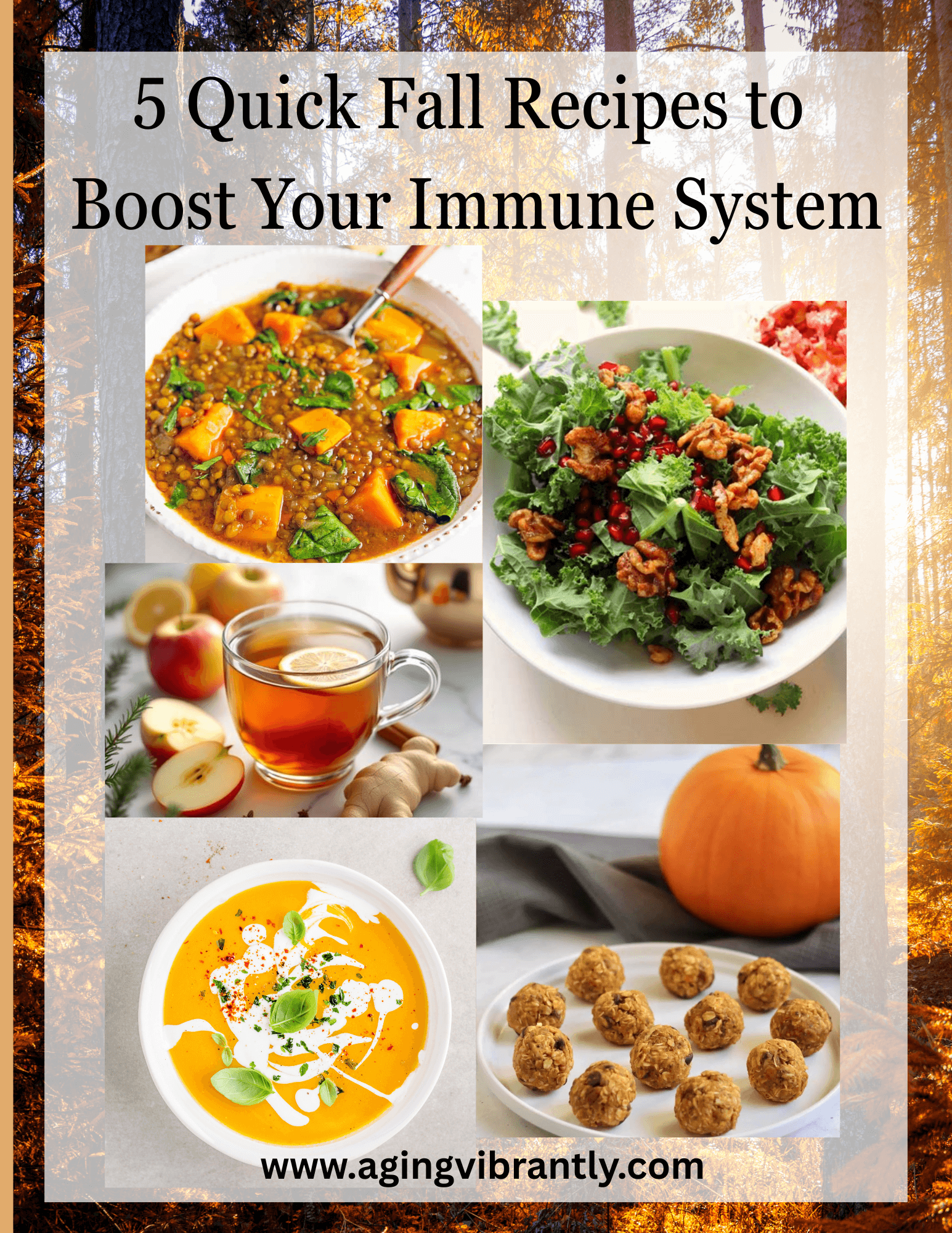

What Foods are you going to try today? Please share in the comments.
Stay connected with us and other fellow Vibrant Agers! Subscribe today and receive our "6 Natural Ways to Optimize Sleep As You Age."
If you found this article helpful? Read more:
Are you in search of a Nutrition Professional to help you individualize your journey?
Visit Nature's Nourished Kitchen and Elizabeth Knowlden!
📚 References – Nutrients & Immunity After 55
- Stephensen, C.B. (2001). Vitamin A, infection, and immune function. Nutrition Reviews, 59(11): 293–307. PubMed Central
- Zhang, L. et al. (2025). Micronutrients as immunomodulators in the ageing population: evidence, gaps and recommendations. Immunity & Ageing. Full Text
- Eggersdorfer, M. et al. (2022). The role of micronutrients and omega-3 long-chain polyunsaturated fatty acids for immune system support. Nutrients, 14(17): 3368. PubMed Central
- Fantacone, M.L. et al. (2020). A multivitamin and mineral supplement enhances immune function in healthy older adults. Nutrients, 12(8): 2447. MDPI
- Meydani, S.N. et al. (2022). Micronutrient requirements for healthy aging: emphasis on immune function. ScienceDirect Review. ScienceDirect
- Fairweather-Tait, S. et al. (2022). Selenium in human health and disease: antioxidant, immune, and anti-inflammatory roles. European Journal of Nutrition. PDF
- Marco, M.L. et al. (2022). Potential modulation of inflammation by probiotic and omega-3 supplements. Frontiers in Nutrition. PubMed Central
- He, T. et al. (2023). The effect of probiotics on immune function in older adults: a systematic review. Aging & Disease, 14(3): 873–889. Journal Link



